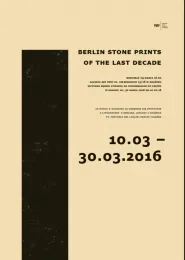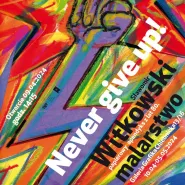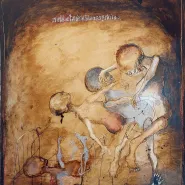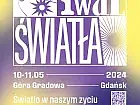Rektor Akademii Sztuk Pięknych w Gdańsku prof. Ludmiła Ostrogórska zaprasza na wystawę:
Podobne wydarzenia
10 kwietnia - 5 maja 2024
Gdańsk,
Galeria ASP
Wstęp wolny
25 października - 8 listopada 2024, godz. 19.00
Gdańsk,
Galeria Triada
Wstęp wolny
"Berlin Stone Prints of the last Decade"
09.03. - 30.03.2016
Wernisaż: 09.03. g. 18.00
Galeria ASP przy ul. Chlebnickiej 13/16 w Gdańsku
Wystawa będzie otwarta od poniedziałku do piątku w dniach 10 - 30 marca 2016 r. od g. 10.00 do 18.00
Lista autorów prac - Lito UDK Berlin
1. Katharina Albers
2. Mohamad-Said Baalbaki
3. Nico Brodersen
4. Sarah Loibl
5. Anton Peitersen
6. Katrin Peters
7. Frank Sievers
8. Anna Slobodnik
Pracownia Litografii Uniwersytetu Sztuk Pięknych w Berlinie
Królewska Akademia Sztuk Plastycznych powstała w Berlinie w 1875 roku, korzystając początkowo z pomieszczeń przy alei Unter den Linden. W latach 1902/03 nastąpiła przeprowadzka do nowo zbudowanej siedziby przy Hardenbergstraße 33, w której Akademia pozostaje do dziś. W tymże gmachu w latach 1904/05 utworzono także Pracownię Litografii.
W tym samym mniej więcej czasie w "Zakładzie Edukacyjnym Pruskiego Muzeum Rzemiosła Artystycznego" w Berlinie powstała specjalistyczna klasa grafiki i książki artystycznej z nauczaniem dziennym, nad którą opiekę sprawował docent Emil Orlik. Począwszy od semestru zimowego w roku 1910/11 zaczęła tam działać pracownia litograficzna, w której zajęcia raz w tygodniu prowadził drukarz o nazwisku Birholz. W semestrze zimowym 1911/12 nauka została poszerzona o dodatkowy dzień, aby uczniom klas graficznych umożliwić zapoznanie się również z technikami pracy. Z kolei działająca już "Pracownia rozwoju sztuki graficznej" w semestrze zimowym 1912/13 poszerzyła nauczanie o ćwiczenia praktyczne w procesie druku, organizując zajęcia już przez 4 dni w tygodniu. Ponadto wprowadzono nauczanie techniki miedziorytu i dwudniowe zajęcia z zakresu druku tapet.
W roku 1924 doszło do połączenia obu placówek edukacyjnych w "Zjednoczone Szkoły Państwowe Sztuki Wyzwolonej i Stosowanej" z siedzibą przy Hardenbergstraße. W 1938 r. po raz kolejny dokonano zmiany nazwy uczelni na "Państwową Wyższą Szkołę Sztuk Plastycznych".
Poszerzenie profilu uczelni o muzykę, aktorstwo i architekturę zaowocowało jej przekształceniem w 1975 roku w Wyższą Szkołę Sztuk Pięknych w Berlinie.
Kolejna, a zarazem ostatnia zmiana nazwy uczelni na Uniwersytet Sztuk Pięknych w Berlinie miała miejsce w 2001 r.
Zadaniem wykładowcy pracowni litograficznej jest przybliżenie studentom kierunków plastycznych oraz przyszłym nauczycielom przedmiotów artystycznych różnych technik litograficznych, a to w ramach kursów tematycznych i realizacji projektów. W pracowni litografii berlińskiego Uniwersytetu Sztuk Pięknych pracuję od 2000 r. Początkowo prowadziłem zajęcia gościnnie, ale już od 2001 r. czynię to na stałe, pracując ze studentami przez 2 dni w tygodniu. W semestrze letnim w 2003 r. nasza pracownia pozyskała jeszcze jednego wykładowcę. Jest to Helmut Müller, który przejął prowadzenie kursów wprowadzających dla studentów.
Od 1992 roku prowadzę także własną pracownię litograficzną "Atelier für Lithografie Steffen Tschesno" w Berlinie-Pankow i zajmuję się drukiem artystycznym na zlecenie indywidualnych twórców.
Berlin, dnia 18.10.2015 r.
Lithography Studio at the Academy of Fine Arts in Berlin
The Royal Academy of Fine Arts was founded in Berlin in 1875, at first using the quarters in Unter den Linden Avenue. During 1902/03 it was moved to the newly built quarters in Hardenbergstraße 33, which remains the quarters of the University till today and which has hosted the Lithography Studio since 1904/05.
A specialized class of graphics and artist's books was established during that time in the "Department of Education of the Prussian Museum of Arts and Crafts" in Berlin, with day classes, with the chairman Associate Professor Emil Orlik. The Lithography Studio was established there at the beginning of the winter term of 1910/11, and once a week, there was a class led by a printer called Birholz. An additional day was added to the course in the winter term of 1911/12 to enable the students of graphics class to learn the working techniques. Later on, in the winter term of 1912/13 the already established "Graphic Art Development Studio" expanded the course adding practical workshop of the process of printing, organizing classes four times a week. Moreover, the teaching of copperplate technique and two-days classes in printing wallpaper were also added.
In 1924 the two educational institutions were joined into the "United State Schools of Liberated and Applied Arts" with the quarters in Hardenbergstraße. In 1938 the name of the school was changed again into the "State School for Fine Arts".
Extending the profile of the school with music, drama and architecture classes resulted in transforming it into the Academy of Fine Arts in Berlin in 1975.
The further and final transformation of the name of the school into the University of Fine Arts in Berlin took place in 2001.
The aim of the lecturer of the lithography studio is to acquaint students with fine arts trends and to instruct the future teachers of fine arts about various lithographic techniques in either the thematic courses and in realization of projects. I have been working in the lithography studio of the University of Fine Arts in Berlin since 2000. At first I was a visiting professor but since 2001 I have been employed permanently, teaching two days a week. In the summer term of 2003 our studio employed another lecturer. It is Helmut Müller who took the lead of the introductory courses for students.
Since 1992 I have been leading my own lithography studio "Atelier für Lithografie Steffen Tschesno" in Berlinie-Pankow and I have been creating art print for individual creators.
Berlin, October 18th, 2015
09.03. - 30.03.2016
Wernisaż: 09.03. g. 18.00
Galeria ASP przy ul. Chlebnickiej 13/16 w Gdańsku
Wystawa będzie otwarta od poniedziałku do piątku w dniach 10 - 30 marca 2016 r. od g. 10.00 do 18.00
Lista autorów prac - Lito UDK Berlin
1. Katharina Albers
2. Mohamad-Said Baalbaki
3. Nico Brodersen
4. Sarah Loibl
5. Anton Peitersen
6. Katrin Peters
7. Frank Sievers
8. Anna Slobodnik
Pracownia Litografii Uniwersytetu Sztuk Pięknych w Berlinie
Królewska Akademia Sztuk Plastycznych powstała w Berlinie w 1875 roku, korzystając początkowo z pomieszczeń przy alei Unter den Linden. W latach 1902/03 nastąpiła przeprowadzka do nowo zbudowanej siedziby przy Hardenbergstraße 33, w której Akademia pozostaje do dziś. W tymże gmachu w latach 1904/05 utworzono także Pracownię Litografii.
W tym samym mniej więcej czasie w "Zakładzie Edukacyjnym Pruskiego Muzeum Rzemiosła Artystycznego" w Berlinie powstała specjalistyczna klasa grafiki i książki artystycznej z nauczaniem dziennym, nad którą opiekę sprawował docent Emil Orlik. Począwszy od semestru zimowego w roku 1910/11 zaczęła tam działać pracownia litograficzna, w której zajęcia raz w tygodniu prowadził drukarz o nazwisku Birholz. W semestrze zimowym 1911/12 nauka została poszerzona o dodatkowy dzień, aby uczniom klas graficznych umożliwić zapoznanie się również z technikami pracy. Z kolei działająca już "Pracownia rozwoju sztuki graficznej" w semestrze zimowym 1912/13 poszerzyła nauczanie o ćwiczenia praktyczne w procesie druku, organizując zajęcia już przez 4 dni w tygodniu. Ponadto wprowadzono nauczanie techniki miedziorytu i dwudniowe zajęcia z zakresu druku tapet.
W roku 1924 doszło do połączenia obu placówek edukacyjnych w "Zjednoczone Szkoły Państwowe Sztuki Wyzwolonej i Stosowanej" z siedzibą przy Hardenbergstraße. W 1938 r. po raz kolejny dokonano zmiany nazwy uczelni na "Państwową Wyższą Szkołę Sztuk Plastycznych".
Poszerzenie profilu uczelni o muzykę, aktorstwo i architekturę zaowocowało jej przekształceniem w 1975 roku w Wyższą Szkołę Sztuk Pięknych w Berlinie.
Kolejna, a zarazem ostatnia zmiana nazwy uczelni na Uniwersytet Sztuk Pięknych w Berlinie miała miejsce w 2001 r.
Zadaniem wykładowcy pracowni litograficznej jest przybliżenie studentom kierunków plastycznych oraz przyszłym nauczycielom przedmiotów artystycznych różnych technik litograficznych, a to w ramach kursów tematycznych i realizacji projektów. W pracowni litografii berlińskiego Uniwersytetu Sztuk Pięknych pracuję od 2000 r. Początkowo prowadziłem zajęcia gościnnie, ale już od 2001 r. czynię to na stałe, pracując ze studentami przez 2 dni w tygodniu. W semestrze letnim w 2003 r. nasza pracownia pozyskała jeszcze jednego wykładowcę. Jest to Helmut Müller, który przejął prowadzenie kursów wprowadzających dla studentów.
Od 1992 roku prowadzę także własną pracownię litograficzną "Atelier für Lithografie Steffen Tschesno" w Berlinie-Pankow i zajmuję się drukiem artystycznym na zlecenie indywidualnych twórców.
Berlin, dnia 18.10.2015 r.
Lithography Studio at the Academy of Fine Arts in Berlin
The Royal Academy of Fine Arts was founded in Berlin in 1875, at first using the quarters in Unter den Linden Avenue. During 1902/03 it was moved to the newly built quarters in Hardenbergstraße 33, which remains the quarters of the University till today and which has hosted the Lithography Studio since 1904/05.
A specialized class of graphics and artist's books was established during that time in the "Department of Education of the Prussian Museum of Arts and Crafts" in Berlin, with day classes, with the chairman Associate Professor Emil Orlik. The Lithography Studio was established there at the beginning of the winter term of 1910/11, and once a week, there was a class led by a printer called Birholz. An additional day was added to the course in the winter term of 1911/12 to enable the students of graphics class to learn the working techniques. Later on, in the winter term of 1912/13 the already established "Graphic Art Development Studio" expanded the course adding practical workshop of the process of printing, organizing classes four times a week. Moreover, the teaching of copperplate technique and two-days classes in printing wallpaper were also added.
In 1924 the two educational institutions were joined into the "United State Schools of Liberated and Applied Arts" with the quarters in Hardenbergstraße. In 1938 the name of the school was changed again into the "State School for Fine Arts".
Extending the profile of the school with music, drama and architecture classes resulted in transforming it into the Academy of Fine Arts in Berlin in 1975.
The further and final transformation of the name of the school into the University of Fine Arts in Berlin took place in 2001.
The aim of the lecturer of the lithography studio is to acquaint students with fine arts trends and to instruct the future teachers of fine arts about various lithographic techniques in either the thematic courses and in realization of projects. I have been working in the lithography studio of the University of Fine Arts in Berlin since 2000. At first I was a visiting professor but since 2001 I have been employed permanently, teaching two days a week. In the summer term of 2003 our studio employed another lecturer. It is Helmut Müller who took the lead of the introductory courses for students.
Since 1992 I have been leading my own lithography studio "Atelier für Lithografie Steffen Tschesno" in Berlinie-Pankow and I have been creating art print for individual creators.
Berlin, October 18th, 2015






